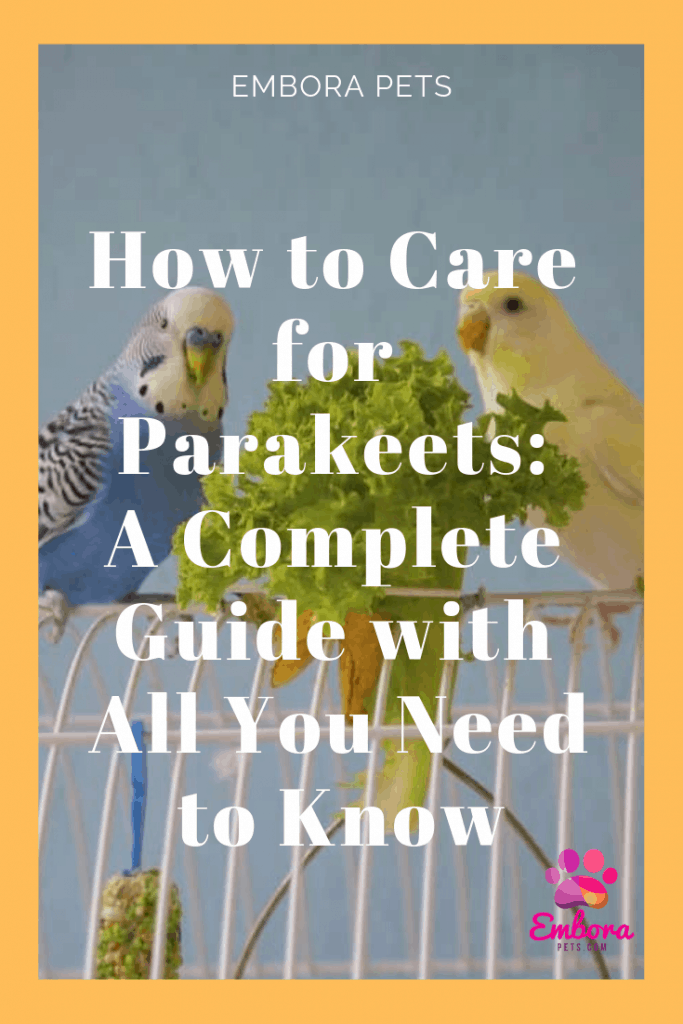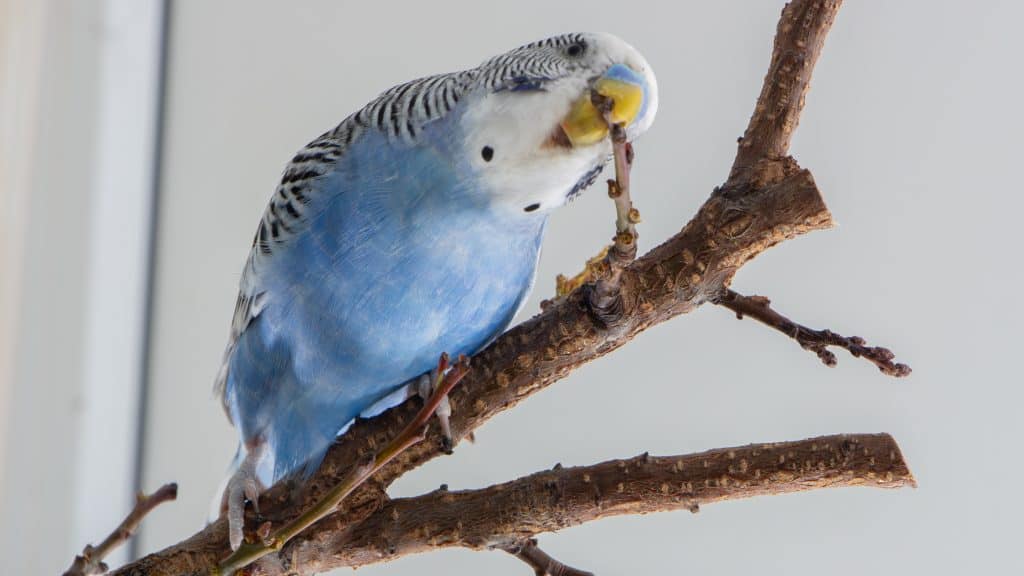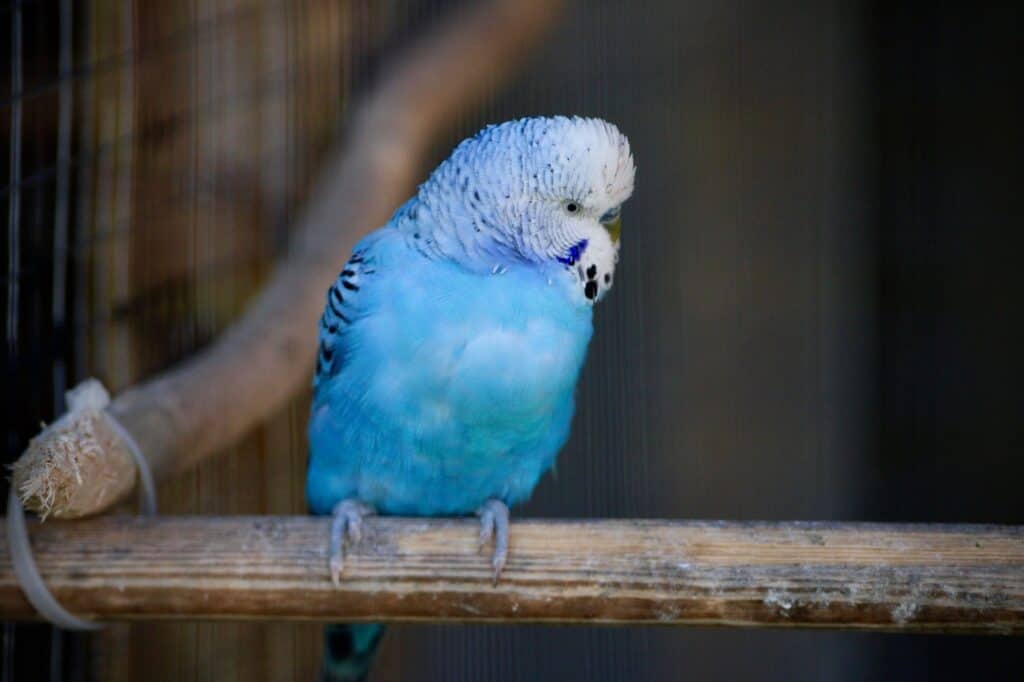What Do Parakeets Eat? And What Shouldn’t Parakeets Eat?
If you’re an aspiring bird owner, one of the most important things to learn is what they can and shouldn’t eat. Yes, there is the classic diet of seeds, but can there be more to it? In this article, I’ll be talking specifically about parakeets.
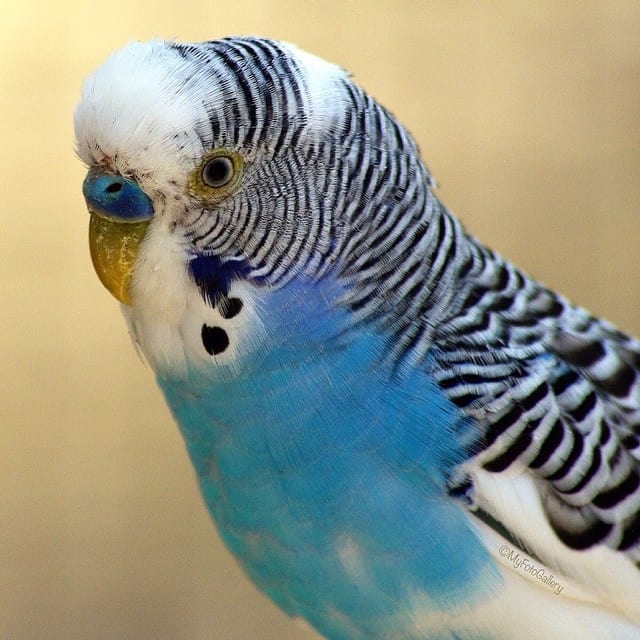
What do parakeets eat?
Parakeets are capable of eating a large variety of fresh fruits and vegetables. They can also eat some foods humans eat, like eggs and chicken. Foods to avoid giving parakeets include chocolate, fruit pits, apple seeds, avocado, and foods high in fat, sodium, and sugars.
Parakeets are not limited to just seeds! Parakeets, after all, are tropical birds, and their diet shows it.
Just like humans need a diet with a variety of foods to keep us healthy and give us essential vitamins, parakeets can and need to eat a diet filled with variety.
There are a plethora of foods that parakeets eat, as they contain great sources of vitamins.
Of course, there are so many more fruits that are acceptable and unacceptable for a parakeet to eat than my little short answer can give and explain.
Fruits Parakeets Eat and Their Benefits
Fruits are rich in vitamins, minerals, and antioxidants. Parakeets eat these fruits:
- Apples
- Oranges
- Bananas
- Grapes
- Coconut
- Pineapple
- Mango
- Apricots: apricots and mangos are both loaded with beta carotene, which is converted into vitamin A.
- Cherries
- Blueberries
- Blackberries
- Melons
- Strawberries: the seeds in strawberries are safe for parakeets to eat, so you won’t need to worry about removing them.
Remember that birds should only be fed fresh fruits.
Added preservatives and dyes that are found in dried or packaged fruits can be bad for your bird, so you and your friend would be better off if you avoided those altogether.
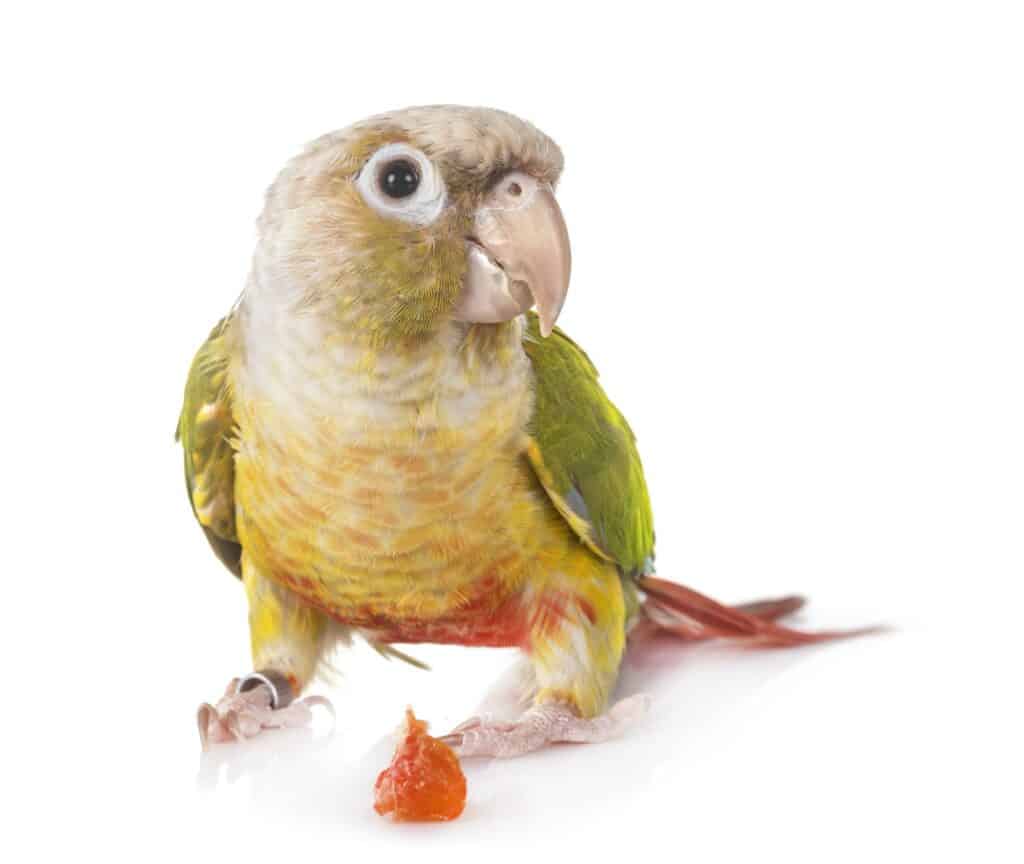
Fruits parakeets eat that provide important nutrients and vitamins include Apples, Oranges, Bananas, Grapes, Coconut, Pineapple, Mango, Apricots, Cherries, Blueberries, Blackberries, Melons, and Strawberries.
Vegetables Parakeets Eat
Parakeets and budgies are granivores, which means these birds eat seeds or grain as a dietary staple. But a typical store-bought seed diet doesn’t give all these necessary vitamins, so vegetables are a very important part of their diet.
When parakeets eat vegetables, they get consume essential vitamins, like vitamins A, B, C, and calcium from sources such as broccoli. Spinach and alfalfa sprouts are rich in vitamins A, E, and K.
Other great vegetables parakeets eat include:
- Leafy vegetables, like kale, romaine lettuce, sprouted seeds, and dandelion leaves. These vegetables are packed with vitamins K and C, fiber, calcium, and iron. Just be sure to rinse them well before!
- Carrots
- Corn
- Peas
- Celery
- Zucchini
- Potatoes
- Asparagus
- Cucumber
- Cooked Beans: they have a wonderful source of protein, and the high amount of fiber will keep your parakeet’s digestive system running smoothly. Before parakeets eat beans, MAKE SURE that the beans are cooked; raw beans are toxic to birds.
Just like fruits, make sure you are feeding your birdie buddy fresh vegetables!
It’s recommended that parakeets eat about 1/2 to 3/4 cup of fruits and vegetables every day.
Nuts Parakeets Eat
While we all know parakeets eat seeds, nuts are full of nutrients that your parakeet probably isn’t getting anywhere else. Plus, Parakeets love nuts! Parakeets eat the following nuts:
- Almonds
- Pistachios
- Peanuts
- Walnuts
- Pecans
Before you feed nuts to your bird, make sure they’re chopped; their throats are incredibly small, and all of these nuts are as big as their heads, so there’s no way they can swallow them whole.
Make sure also that shells are not included, as your parakeet won’t bother with them.
Parakeets eating nut shells is a choking hazard and could damage their mouth, throats, and guts and cause digestive issues, so avoid giving them any shelled nuts.
Other Appropriate Foods Pet Parakeets Eat
Parakeets eat lot of foods that humans can eat, even some that you probably never thought of before:
Pellets
Pellets are another main staple in a parakeet’s diet. Get a high-quality bird pellet from a pet store or from your vet; grocery store varieties have artificial coloring, flavors, and preservatives that aren’t so healthy for a bird.
Protein
While protein can be obtained through a parakeet’s seed mixtures, other sources of protein that are good for birds include hard-boiled eggs, tuna packed in water, and other types of cooked meats like chicken- make sure the meat is thoroughly cooked before you feed it to your feathery friend.
Corn
Parakeets eat raw or cooked corn, which is another good option for protein. If you want to supplement protein to your bird through these ways, keep in mind that fresh protein should be limited for parakeets (about a fingertip’s amount) every two weeks.
Remember that wild parakeets spend all day snacking on protein-rich foods like bugs and worms. Wild parakeets eat a huge variety of food!
Giving it small amounts of protein along with its seed in your parakeet’s diet will make up for it and more emulate the natural diet of wild parakeets.
Baby food
Crazy, right?! Feeding an animal baby food? Well, some parakeet owners can opt to implement baby food into their bird’s diet (as long as it is made from all natural ingredients and they contain vegetables). It’s convenient if you don’t have fresh vegetables on hand.
Bread
Parakeets eat whole grain bread that can be broken up into small bits and fed to your bird.
Try to stick to simple whole grain bread, as sweet bread may contain ingredients that are harmful to parakeets.
Some fun variations of bread can be through dried rolls or rusks (twice-baked bread).
Cuttlebone
Cuttlebones are those flat, oval-shaped discs you see in the bird section at the pet store.
They’re essentially a mineral block. Like its name, it’s the internal skeleton of a cephalopod called the cuttlefish.
When parakeets eat at a cuttlebone, not only can it keep your bird’s beak and claws trimmed, it’s a good source of calcium and other minerals for your parakeet, which are difficult for them to get otherwise; hang it in their cage and let them gnaw away.
Snacks and Treats Parakeets Eat
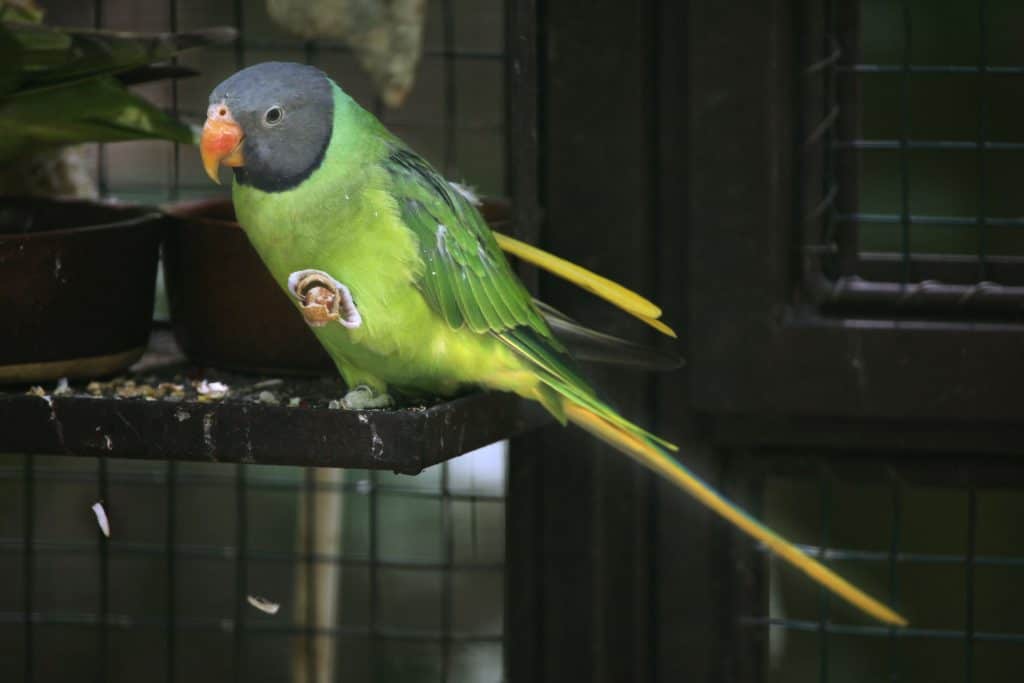
Like any person or animal, parakeets love getting occasional treats. There are a lot of different ways that you can treat your parakeet:
Peanut butter
It’s another great source of protein and a super tasty treat for parakeets. Try smearing some on a celery stick and feeding it to your feathered friend.
Pasta
Whether raw or cooked, birds love pasta! They’re full of carbohydrates, which enhance a bird’s energy levels. Try mixing pasta with your parakeet’s favorite vegetables.
For birds that like a crunch, you can give them some raw macaroni noodles filled with nut butter. Make sure that any cooked pasta that’s fed is cool.
Honey
Honey is a very sweet treat that parakeets will like. Remember that honey has many calories, so it should be saved for special occasions.
Millet
Millets are small seed grasses. They’ve been a staple to birds and animals for ages.
I would recommend spray millet (it looks like corn on the cob or a stick with a bump of mock strawberries all over) or white proso millet, a favorite among most birds.
Spray millet can cause a bit of a mess if clipped to the inside of the cage; one way to fix this is by hanging it from the ceiling of the cage.
It’s important to ensure your parakeet is eating regular food; they may want to substitute seed for treats, which won’t be good for them.
A kid who eats too much candy can get hyper and crash with an upset stomach later on, and the calories can cause weight gain.
Some of these treats, like honey and millet, are all sweets and calories with little nutritional value- feeding them too much can cause weight gain and other health problems.
Most Toxic Foods for Parakeets
Chocolate
Just like you’ve been told that chocolate is dangerous for dogs, it’s the same for parakeets.
Chocolate contains theobromine and caffeine, which can cause hyperactivity, increased heart rate, tremors, possibly seizures, and even death in pets if it’s ingested at a toxic dose.
The darker and more bitter chocolate is, the more toxic it is to your pet.
Onion/Garlic
Onions and garlic contain an ingredient called thiosulphate, which is toxic to animals. Ingestion of these foods can cause a condition called hemolytic anemia, where red blood cell’s in a pet’s body burst, and gastroenteritis, or inflammation of the stomach and intestines.
Comfrey
Comfrey is a plant that can be identified by its small, purple or magenta-colored, bell-like flowers. Studies of human medicine trace this plant to cause liver damage.
Avocado
The avocado plant contains
Fruit Pits and Apple Seeds
While the fruit of an apple is safe for pet birds, the seeds contain cyanide and should always be removed prior to feeding the apple to a bird.
Cyanide is also contained in cherry, plum, apricot, and peach pits, so you should never allow your bird to chew on them.
High-Fat, High-Sodium, High-Sugar Foods
While table foods with these high concentrations aren’t toxic, they can cause serious health problems for birds.
Too much salt can upset a bird’s electrolyte and fluid balance, leading to excessive thirst, dehydration, kidney failure, and death.
For example, if you’re going to roast some carrots or potatoes in the oven, give your bird one that hasn’t been seasoned.
Sugar-Free Candy
These sweets contain xylitol, which is associated with severe hypoglycemia and liver damage.
Certain plants
Potatoes, peppers, and eggplants are foods that are safe for birds to eat, but the plants themselves are toxic. The leaves of the rhubarb plant contain oxalate crystals, which can cause kidney problems.
Non-Toxic, but Not Recommended, Foods Parakeets Should Avoid
The following foods aren’t technically toxic to a bird, but they should avoid giving them to your parakeet or only feed them to them in very small quantities:
Peanuts
Avoid giving your parakeet moldy peanuts or peanut products, since a toxin-producing fungus can contaminate them.
Dairy
Birds lack an enzyme that’s responsible for the fragmentation of lactose. While dairy is technically non-toxic, including a lot of dairy in a bird’s diet can give them diarrhea.
Some cheese and yogurts contain little or no lactose, such as lean curd cheese, but still, these foods should be fed occasionally and in small amounts.
Mushrooms
Mushrooms that people can eat are also considered safe for pets. But do not feed false morel (or Gyromitra) mushrooms to your bird, let alone eat them yourself; cooking can make these mushrooms less toxic, but it doesn’t completely rid their danger of death.
Grit
Parakeets might consume large amounts of grits when they’re not feeling well, which puts them at risk of intestinal blockage.
Crackers
Yes, some crackers have grain in them, which is 90% of a parakeet’s diet, but they don’t offer any nutritional value to humans or birds.
Plenty of other things would be better to feed your bird.
Tomatoes
Tomatoes have a high acidic content, so they are not recommended for your parakeet. There are acceptions, such as dried tomatoes and spaghetti sauce, as the acid is removed in the process of making these foods.
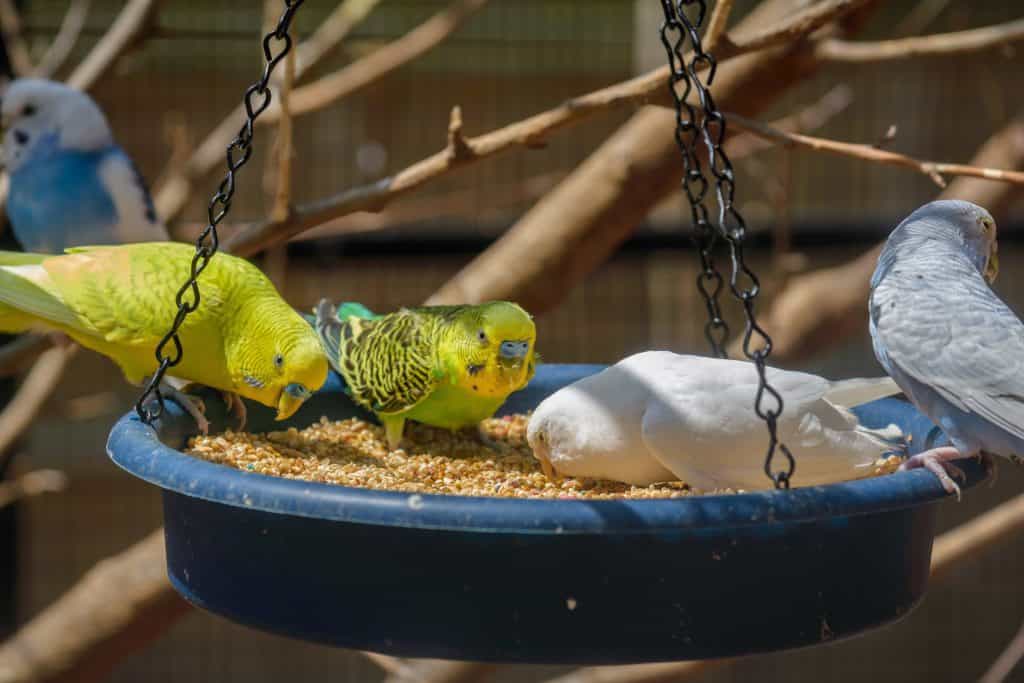
Tips for Feeding Your Pet Parakeet
Every parakeet is different with their food preferences, so try and experiment with different types of foods to see what they like, what they don’t like, and what their favorite foods are.
Remember to keep whatever food you feed your bird bite-size. Parakeets are very small, incredibly light creatures- their average weight ranges between 25 to 35 grams or 0.8 to 1 ounce!
If you give them an entire head of broccoli or even an apple slice, they’re going to have a hard time breaking it apart and eating it.
Save them the trouble and chop up their food so they can eat it with ease.
One way to find out what foods your bird likes is to give them a bowl filled with various fruits.
At the end of the day, remove any uneaten fruit so they don’t go bad inside the cage. If they eat certain pieces while ignoring others, give them what they like.
Your parakeet might get bored from getting the same meal every day, so mix things up with a fruit kabob or dangle them inside their cage to make eating more exciting.
Parakeets are also big fans of warm fruit, so pop their meal in the microwave before giving it to them.
Make sure that if you feed your bird any cooked food to wait for it to cool first before serving it to them; human food is served hot, and while we can tolerate a certain heat, parakeets can get seriously burned.
To avoid your bird snacking on anything that they probably shouldn’t keep them away from your plate.
If you like to eat with your bird, you can get them used to eating out of their own little plate, so they won’t feel tempted to take something from yours.
While most parakeets eat seeds and seeds alone, don’t be afraid to safely experiment with your parakeet’s diet! Wild parakeets get a huge variety of foods, so so should your pet parakeet!
Related Questions:
Are there any foods that are normally healthy that become do-not-feed for birds in certain conditions?
Pet birds that suffer from candidiasis should not consume any sugar during their treatment because the yeast nourishes on it. Fructose is the same as sugar, so fruit is not allowed. Birds with avian gastric yeast may vary in whether they can eat fruit depending on the treatment they are given. It’s important to discuss the proper bird diet with your vet to make sure you don’t accidentally feed them the wrong thing.
How often do parakeets eat?
Parakeets tend to eat about a pound of birdseed each month. This is around 3 teaspoons a day. However, this can be different depending on their age and their overall health. If you think your parakeet is over or under eating, you might want to consult a veterinarian.
Related Articles Just For You!
If you found this article about what Parakeets can and cannot eat helpful, I suggest checking out one of these other articles.
Summary
This article provides a guide for feeding parakeets, which are granivorous birds that require more than seeds. Here are the main points to remember:
- Domesticated and wild parakeets eat a wide variety of fruits and vegetables, as well as some human foods like eggs and chicken. They should avoid giving foods like chocolate, fruit pits, apple seeds, avocado, and foods high in fat, sodium, and sugars.
- Fruits that parakeets eat include apples, oranges, bananas, grapes, coconut, pineapple, mango, apricots, cherries, blueberries, blackberries, melons, and strawberries.
- Fresh vegetables that parakeets eat include kale, romaine lettuce, broccoli, spinach, alfalfa sprouts, dandelion leaves, carrots, corn, peas, celery, zucchini, potatoes, asparagus, cucumber, and cooked beans.
- Nuts that parakeets eat include almonds, pistachios, peanuts, walnuts, and pecans, but they should be chopped and have no shells.
- Other foods that parakeets eat include pellets, hard-boiled eggs, tuna packed in water, cooked meats like chicken, corn, baby food made from natural ingredients, and whole grain bread.

